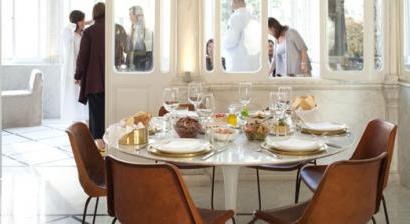
There's a lot to consider when choosing dining furniture – the dimensions of your dining space, how many people you need to accommodate and what style will suit your home. Here are some expert tips to help you out:
Rectangular or round? A clean-lined rectangular table fits many needs – it's adaptable, works for a few diners or a crowd and is the right shape for most modern dining spaces. A table with extendable leaves will come into its own when the extended family gathers for Christmas dinner.
Round tables, especially those with a central pedestal, can be perfect for a small space. Round or oval tables are intimate and good for conversation – especially if they're not too big. And if your home is dominated by straight lines, a curved table offers a softer touch.
Will everything fit? When you're about to buy dining furniture, measure your dining space carefully before you commit. Rough out the spaces on a plan drawn to scale, or cut pieces of newspaper the same size as your table, chairs and other dining room furniture and place them in the actual space.
Make sure traffic can move smoothly around the table and that you won't feel cramped. Interior designer Sylvia Sandford says there should be at least 80cm between the back of the chair and the wall. "You should have room to push your chair back comfortably and stand up behind it."
Think about conversation and elbow room when selecting a table – will everyone be comfortable, but close enough to chat? "I recommend a minimum of 60cm of table edge per diner, but it will depend on the size of the place setting and also the type of atmosphere you would like to create – if it's a shared meal, you might not mind everyone jostling together," Sandford says.
Chair choices: For formal dining rooms consider fully upholstered chairs which will be more comfortable for sitting for long periods, but in more casual spaces choose a chair that moves easily and can be pulled out with one hand while the other is holding a drink or coffee, says Sandford. There are lots of stylish stacking options available, which means you can keep a spare but matching set for extra guests. Many parents swear by dining chairs that can be wiped clean after the inevitable spills (you can easily add a slim cushion for comfort) and washable slip covers are another option if you like the fabric look but are worried about mess.
Consider how the chairs work with a table, especially if you're buying them separately. Sit down and cross your legs – there should be space between the edge of the table and your thighs, but also make sure the chair is not too low.
The open-plan effect: In an open-plan setting, furniture can be seen from all sides. Invest in a table and shapely chairs that look good from all angles and think about how you'll see it from key vantage points when you're grouping furniture. A traditional dressed-up dining area can be hard to pull off in an open-plan space. Consider a looser, less structured vibe – maybe mismatched vintage chairs with a glossy modern table, or a worn refectory-style oak table with designer chairs.
Small spaces: If you've only got a tiny area for dining, you can still create a workable, appealing space. Go for adaptable, multi-purpose solutions. Islands and cantilevered counters can work as both kitchen prep space and eating area, as long as you're disciplined about clutter. Consider space-saving built-in furniture such as booth seating.
Optional extras: When planning a dining room, think about how you will serve food. A buffet off to the side of the dining table may be handy for placing platters once people have served themselves, so that the table is not too crowded.
A fabulous overhead pendant may suit your design scheme but bear in mind that harsh overhead light can be a mood killer. Opt for dimmable lighting and look for softer, more atmospheric back-ups such as walls sconces and well-placed floor and table lamps.
(Source: stuff.co.nz Author: ROSEMARY BARRACLOUGH)























 沪公网安备31010402003309号
沪公网安备31010402003309号